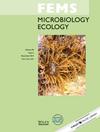原核生物的形态特征和维护活动受季节性生产力条件的制约。
IF 3.5
3区 生物学
Q2 MICROBIOLOGY
引用次数: 0
摘要
原核生物的维持性呼吸和相关代谢活动在海洋混合层碳转化为二氧化碳的总呼吸量中占有相当大的比例。然而,在低生产力(冬季)和高生产力(夏季)条件下,原核生物的形态和代谢适应性对原核生物维持活动的季节性影响尚不清楚。为了解决这个问题,我们在中观宇宙尺度上研究了自然原核生物群落,分析了它们在低和高维持呼吸作用下的形态特征和基因表达的差异,并通过实验操纵了特定的生长率。在这里,我们发现在高生产率条件下,原核生物群落的形态特征包括膜破裂、膜囊泡和细胞间连接。在低生产率条件下,观察到了与维持活动相关的代谢适应。在模拟的冬季条件下,与信号转导、能量代谢和翻译机制有关的几个《京都基因与基因组百科全书》类别支持维持活动。与转运体、渗透调节、氮代谢、核糖体生物发生和冷应激有关的基因丰度存在差异。我们的研究结果表明,不同季节的特定生长率会在形态特征和代谢适应性水平上影响资源分配。这促使我们进一步研究高生产力期间的形态特征及其生态作用,而对低生产力期间代谢适应性的研究则能增进我们对维持活动的了解。本文章由计算机程序翻译,如有差异,请以英文原文为准。
Prokaryotic morphological features and maintenance activities governed by seasonal productivity conditions.
Prokaryotic maintenance respiration and associated metabolic activities constitute a considerable proportion of the total respiration of carbon to CO2 in the ocean's mixed layer. However, seasonal influences on prokaryotic maintenance activities in terms of morphological and metabolic adaptations at low (winter) and high productivity (summer) are still unclear. To address this, we examined the natural prokaryotic communities at the mesocosm scale to analyse the differences in their morphological features and gene expression at low and high maintenance respiration, experimentally manipulated with the specific growth rate. Here, we showed that morphological features including membrane blebbing, membrane vesicles and cell‒cell connections occurred under high productivity. Metabolic adaptations associated with maintenance activities were observed under low productivity. Several Kyoto Encyclopedia of Genes and Genomes categories related to signal transduction, energy metabolism, and translational machinery supported maintenance activities under simulated winter conditions. Differential abundances of genes related to transporters, osmoregulation, nitrogen metabolism, ribosome biogenesis, and cold stress were observed. Our results demonstrate how specific growth rate in different seasons can influence resource allocation at the levels of morphological features and metabolic adaptations. This motivates further study of morphological features and their ecological role during high productivity, while investigations of metabolic adaptations during low productivity can advance our knowledge about maintenance activities.
求助全文
通过发布文献求助,成功后即可免费获取论文全文。
去求助
来源期刊

FEMS microbiology ecology
生物-微生物学
CiteScore
7.50
自引率
2.40%
发文量
132
审稿时长
3 months
期刊介绍:
FEMS Microbiology Ecology aims to ensure efficient publication of high-quality papers that are original and provide a significant contribution to the understanding of microbial ecology. The journal contains Research Articles and MiniReviews on fundamental aspects of the ecology of microorganisms in natural soil, aquatic and atmospheric habitats, including extreme environments, and in artificial or managed environments. Research papers on pure cultures and in the areas of plant pathology and medical, food or veterinary microbiology will be published where they provide valuable generic information on microbial ecology. Papers can deal with culturable and non-culturable forms of any type of microorganism: bacteria, archaea, filamentous fungi, yeasts, protozoa, cyanobacteria, algae or viruses. In addition, the journal will publish Perspectives, Current Opinion and Controversy Articles, Commentaries and Letters to the Editor on topical issues in microbial ecology.
- Application of ecological theory to microbial ecology
- Interactions and signalling between microorganisms and with plants and animals
- Interactions between microorganisms and their physicochemical enviornment
- Microbial aspects of biogeochemical cycles and processes
- Microbial community ecology
- Phylogenetic and functional diversity of microbial communities
- Evolutionary biology of microorganisms
 求助内容:
求助内容: 应助结果提醒方式:
应助结果提醒方式:


